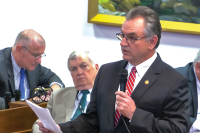Skaters find their groove at Waynesville’s new concrete playground
Skateboarders from across Western North Carolina have streamed into Waynesville during the past week to try out the town’s newly opened $400,000 skate park.
Nature-inspired metal artist garners acclaim from unusual fanbase
 A fiery inferno blasts through the sheet metal like a hot knife through butter. The screeching sound of a grinder echoes down into the valley surrounding Waynesville. Flipping up her face shield, metal sculptor Grace Cathey wipes her brow, smiles momentarily then shuts the mask back down. She’s in the midst of her creation and all focus is on the task at hand.
A fiery inferno blasts through the sheet metal like a hot knife through butter. The screeching sound of a grinder echoes down into the valley surrounding Waynesville. Flipping up her face shield, metal sculptor Grace Cathey wipes her brow, smiles momentarily then shuts the mask back down. She’s in the midst of her creation and all focus is on the task at hand.
“I’ve been an artist in this area for over 32 years and I’ve had so much support from the community. It’s overwhelming and I feel so blessed,” she said. “I chose this community because I knew this would be a great place to live, and it has been.”
Grace Cathey’s metal flowers to join the ranks of Waynesville public art pieces
 A new public art sculpture will be unveiled in downtown Waynesville this week by renowned Western North Carolina metal sculptor Grace Cathey.
A new public art sculpture will be unveiled in downtown Waynesville this week by renowned Western North Carolina metal sculptor Grace Cathey.
Curtain call: Waynesville welcomes revival of the Strand theater
 When Rodney and Lorraine Conard took the keys to the shuttered Strand movie theater two years ago, the hulking shell was like a blank canvas full of promise — a tad dusty, worn and tattered, but it was loved once and surely could win Waynesville’s heart again.
When Rodney and Lorraine Conard took the keys to the shuttered Strand movie theater two years ago, the hulking shell was like a blank canvas full of promise — a tad dusty, worn and tattered, but it was loved once and surely could win Waynesville’s heart again.
Waynesville taps into craft beer festival
 The inaugural Waynesville Craft Beer Festival will be from 1 to 5 p.m. Saturday, Aug. 31, at the American Legion baseball field in Waynesville.
The inaugural Waynesville Craft Beer Festival will be from 1 to 5 p.m. Saturday, Aug. 31, at the American Legion baseball field in Waynesville.
Waynesville puts brakes on the slow creep of sandwich boards, for now
Pending changes to Waynesville’s sign laws could pave the way for sidewalk sandwich boards downtown, but they aren’t legal yet.
Buskers: coming soon to a street corner near you
 Waynesville officials will hold a public hearing next week on an ordinance that would pave the way for street performers, known colloquially as “buskers,” to play in the town’s public spaces in hopes of making a buck or two from passersby.
Waynesville officials will hold a public hearing next week on an ordinance that would pave the way for street performers, known colloquially as “buskers,” to play in the town’s public spaces in hopes of making a buck or two from passersby.
No bailout for Lake Junaluska
 Lake Junaluska community leaders gave residents a first look at how its service fees will increase since its merger with Waynesville was thwarted, at least temporarily.
Lake Junaluska community leaders gave residents a first look at how its service fees will increase since its merger with Waynesville was thwarted, at least temporarily.
Waynesville VFW post reopens following alcohol, gambling charges
 Following a nine-month undercover investigation, six people were charged with conducting illegal activities, including selling moonshine and gambling, at the Veterans of Foreign Wars Post in Waynesville.
Following a nine-month undercover investigation, six people were charged with conducting illegal activities, including selling moonshine and gambling, at the Veterans of Foreign Wars Post in Waynesville.
Wells Funeral Home brings multi-purpose event center to downtown Waynesville
 A new event center in Waynesville could be just the beginning of the vitalization of Wall Street, said Wells Greeley, owner of Wells Funeral Homes and Cremation Services.
A new event center in Waynesville could be just the beginning of the vitalization of Wall Street, said Wells Greeley, owner of Wells Funeral Homes and Cremation Services.





